

|
|
Δείτε εδώ τα πιο πρόσφατα μηνύματα από όλες τις περιοχές συζητήσεων, καθώς και όλες τις υπηρεσίες της AcroBase. H εγγραφή σας είναι γρήγορη και εύκολη. |
|
|||||||
|
 |
|
|
Εργαλεία Θεμάτων | Τρόποι εμφάνισης |
 |
#3526
|
 |
|
||||
|
Discover the cosmos! Each day a different image or photograph of our fascinating universe is featured, along with a brief explanation written by a professional astronomer. 2016 May 22 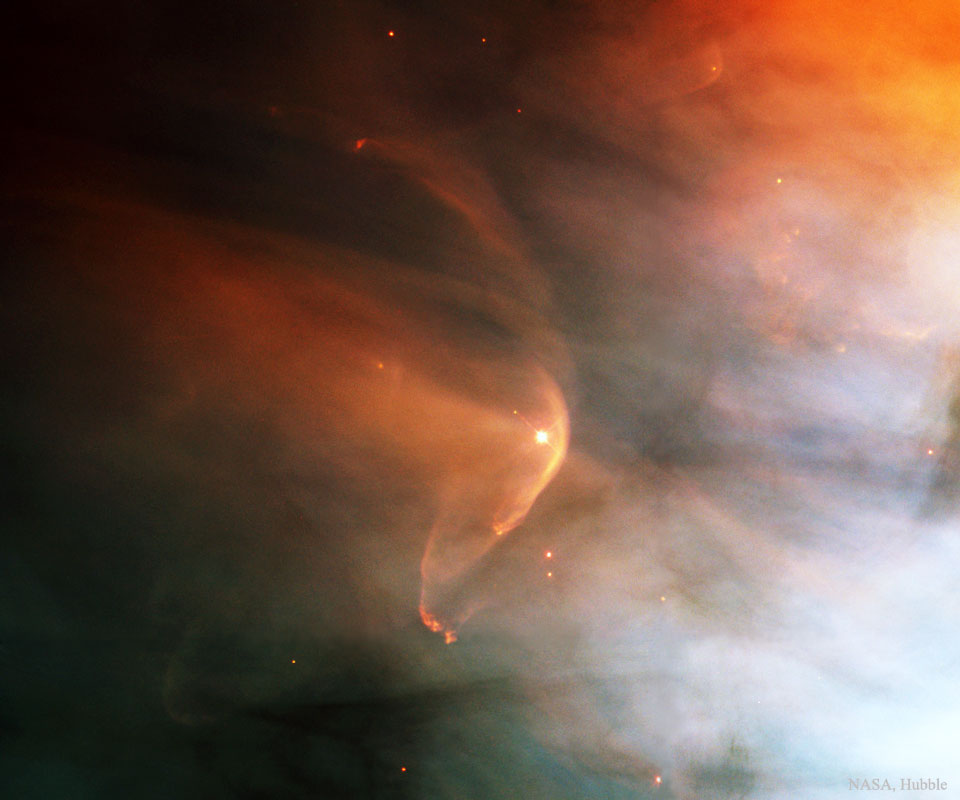 Image Credit: Hubble Heritage Team (AURA / STScI), C. R. O'Dell(Vanderbilt U.), NASA Explanation: What created this great arc in space? This arcing, graceful structure is actually a bow shock about half a light-year across, created as the wind from young star LL Orionis collides with the Orion Nebula flow. Adrift in Orion's stellar nursery and still in its formative years, variable star LL Orionis produces a wind more energetic than the wind from our own middle-aged sun. As the fast stellar wind runs into slow moving gas a shock front is formed, analogous to the bow wave of a boat moving through water or a plane traveling at supersonic speed. The slower gas is flowing away from the Orion Nebula's hot central star cluster, the Trapezium, located off the lower right hand edge of the picture. In three dimensions, LL Ori's wrap-around shock front is shaped like a bowl that appears brightest when viewed along the "bottom" edge. The complex stellar nursery in Orion shows a myriad of similar fluid shapes associated with star formation, including the bow shock surrounding a faint star at the upper right. Part of a mosaic covering the Great Nebula in Orion, this composite color image was recorded in 1995 by the Hubble Space Telescope.
__________________
όταν γράφεται η ιστορία της ζωής σου, μην αφήνεις κανέναν να κρατάει την πένα |
 |
#3527
|
 |
|
||||
|
Discover the cosmos! Each day a different image or photograph of our fascinating universe is featured, along with a brief explanation written by a professional astronomer. 2016 May 23 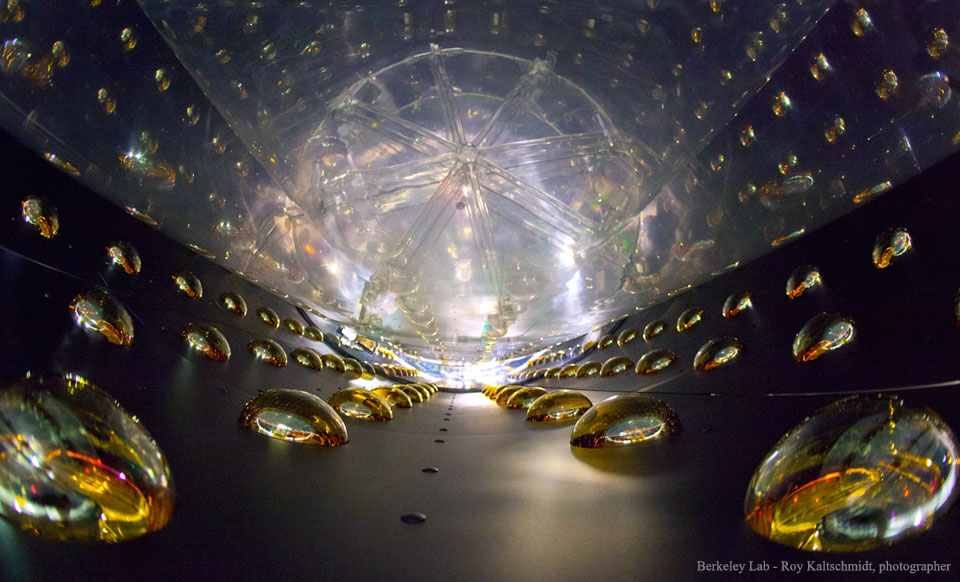 Image Credit & Copyright: DOE, Berkeley Lab - Roy Kaltschmidt, photographer Explanation: Why is there more matter than antimatter in the Universe? To better understand this facet of basic physics, energy departments in China and the USA led in the creation of the Daya Bay Reactor Neutrino Experiment. Located under thick rock about 50 kilometers northeast of Hong Kong, China, eight Daya Bay detectors monitor antineutrinos emitted by six nearby nuclear reactors. Featured here, a camera looks along one of the Daya Bay detectors, imaging photon sensors that pick up faint light emitted by antineutrinos interacting with fluids in the detector. Early results indicate an unexpectedly high rate of one type of antineutrino changing into another, a rate which, if confirmed, could imply the existence of a previously undetected type of neutrino as well as impact humanity's comprehension of fundamental particle reactions that occurred within the first few seconds of the Big Bang. Astrophysicists: Browse 1,250+ codes in the Astrophysics Source Code Library
Tomorrow's picture: diagonal peaks
__________________
όταν γράφεται η ιστορία της ζωής σου, μην αφήνεις κανέναν να κρατάει την πένα |
 |
#3528
|
 |
|
||||
|
Discover the cosmos! Each day a different image or photograph of our fascinating universe is featured, along with a brief explanation written by a professional astronomer. 2016 May 24 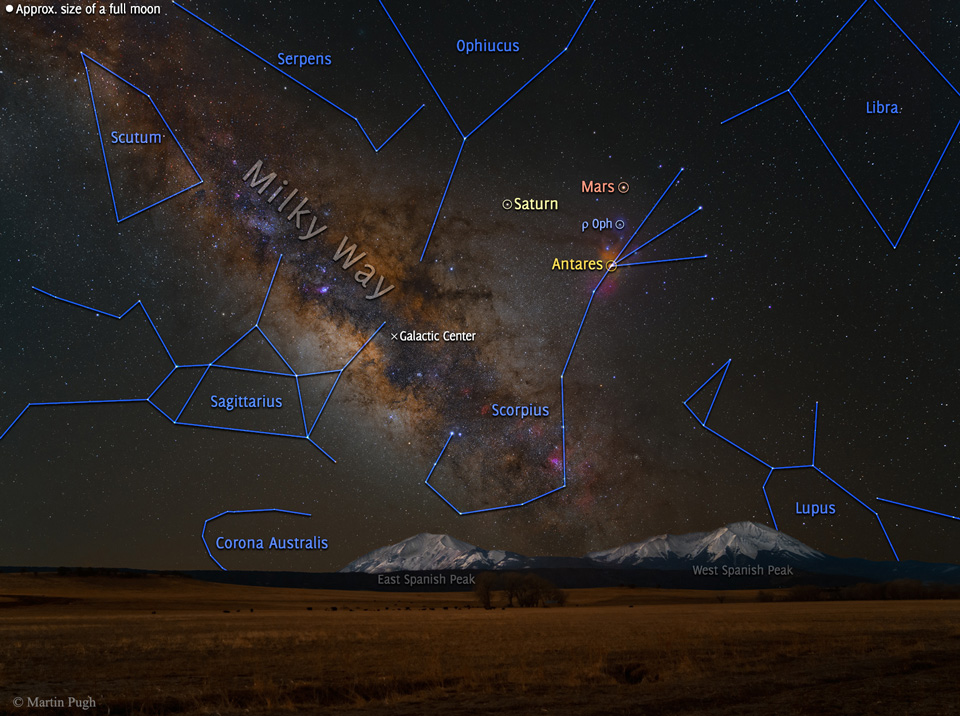 Image Credit & Copyright: Martin Pugh; Rollover Annotation: Judy Schmidt Explanation: That's not lightning, and it did not strike between those mountains. The diagonal band is actually the central band of our Milky Way Galaxy, while the twin peaks are actually called the Spanish Peaks -- but located in Colorado, USA. Although each Spanish peak is composed of a slightly different type of rock, both are approximately 25 million years old. This serene yet spirited image composite was meticulously created by merging a series of images all taken from the same location on one night and early last month. In the first series of exposures, the background sky was built up, with great detail being revealed in the Milky Way dust lanes as well as the large colorful region surrounding the star Rho Ophiuchus just right of center. One sky image, though, was taken using a fogging filter so that brighter stars would appear more spread out and so more prominent. As a bonus, the planets Mars and Saturn are placed right above peaks and make an orange triangle with the bright star Antares. Later that night, after the moonrise, the Moon itself naturally illuminated the snow covered mountain tops.
__________________
όταν γράφεται η ιστορία της ζωής σου, μην αφήνεις κανέναν να κρατάει την πένα |
 |
#3529
|
 |
|
||||
|
Discover the cosmos! Each day a different image or photograph of our fascinating universe is featured, along with a brief explanation written by a professional astronomer. 2016 May 25  Image Credit & Copyright: Dietmar Hager, Eric Benson Explanation: This sharp telescopic field of view holds two bright galaxies. Barred spiral NGC 5101 (top right) and nearly edge-on system NGC 5078 are separated on the sky by about 0.5 degrees or about the apparent width of a full moon. Found within the boundaries of the serpentine constellation Hydra, both are estimated to be around 90 million light-years away and similar in size to our own large Milky Way galaxy. In fact, if they both lie at the same distance their projected separation would be only 800,000 light-years or so. That's easily less than half the distance between the Milky Way and the Andromeda Galaxy. NGC 5078 is interacting with a smaller companion galaxy, cataloged as IC 879, seen just left of the larger galaxy's bright core. Even more distant background galaxies are scattered around the colorful field. Some are even visible right through the face-on disk of NGC 5101. But the prominent spiky stars are in the foreground, well within our own Milky Way.
__________________
όταν γράφεται η ιστορία της ζωής σου, μην αφήνεις κανέναν να κρατάει την πένα |
 |
#3530
|
 |
|
||||
|
Discover the cosmos! Each day a different image or photograph of our fascinating universe is featured, along with a brief explanation written by a professional astronomer. 2016 May 26 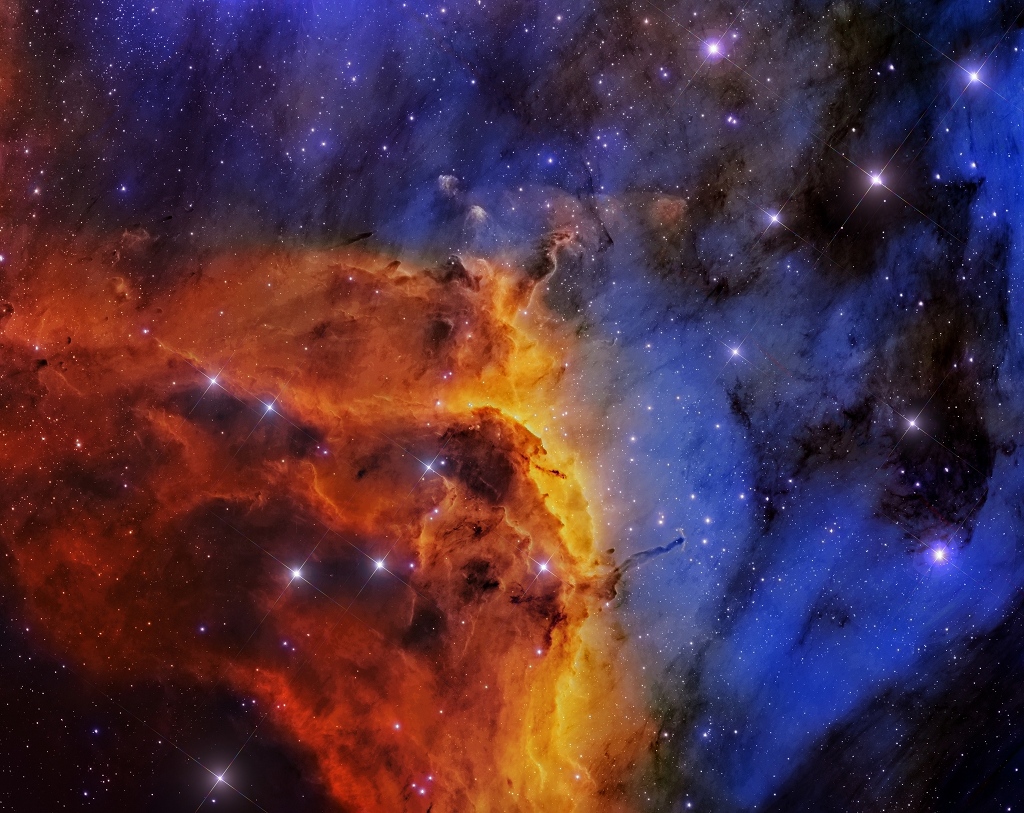 Image Credit & Copyright: Data - Subaru Telescope (NAOJ), R. Colombari, Processing - Roberto Colombari Explanation: The prominent ridge of emission featured in this sharp, colorful skyscape is cataloged as IC 5067. Part of a larger emission nebula with a distinctive shape, popularly called The Pelican Nebula, the ridge spans about 10 light-years following the curve of the cosmic pelican's head and neck. This false-color view also translates the pervasive glow of narrow emission lines from atoms in the nebula to a color palette made popular in Hubble Space Telescope images of star forming regions. Fantastic, dark shapes inhabiting the 1/2 degree wide field are clouds of cool gas and dust sculpted by the winds and radiation from hot, massive stars. Close-ups of some of the sculpted clouds show clear signs of newly forming stars. The Pelican Nebula, itself cataloged as IC 5070, is about 2,000 light-years away. To find it, look northeast of bright star Deneb in the high flying constellation Cygnus.
__________________
όταν γράφεται η ιστορία της ζωής σου, μην αφήνεις κανέναν να κρατάει την πένα |
 |
#3531
|
 |
|
||||
|
Discover the cosmos! Each day a different image or photograph of our fascinating universe is featured, along with a brief explanation written by a professional astronomer. 2016 May 27 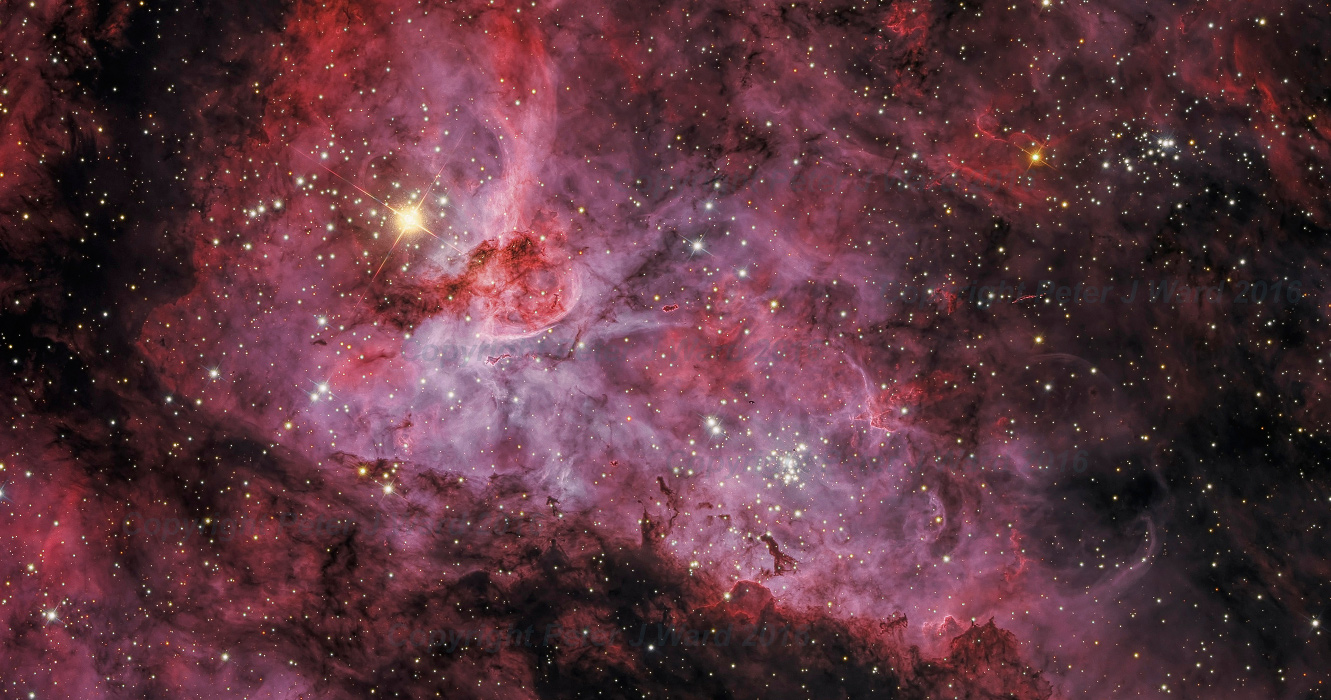 Image Credit & Copyright: Peter Ward (Barden Ridge Observatory) Explanation: A jewel of the southern sky, the Great Carina Nebula, also known as NGC 3372, spans over 300 light-years, one of our galaxy's largest star forming regions. Like the smaller, more northerly Great Orion Nebula, the Carina Nebula is easily visible to the unaided eye, though at a distance of 7,500 light-years it is some 5 times farther away. This gorgeous telescopic close-up reveals remarkable details of the region's central glowing filaments of interstellar gas and obscuring cosmic dust clouds. The field of view is over 50 light-years across. The Carina Nebula is home to young, extremely massive stars, including the stars of open cluster Trumpler 14 (below and right of center) and the still enigmatic variable Eta Carinae, a star with well over 100 times the mass of the Sun. Eta Carinae is the brightest star, seen here just above the dusty Keyhole Nebula (NGC 3324). While Eta Carinae itself maybe on the verge of a supernova explosion, X-ray images indicate that the Great Carina Nebula has been a veritable supernova factory.
__________________
όταν γράφεται η ιστορία της ζωής σου, μην αφήνεις κανέναν να κρατάει την πένα |
 |
#3532
|
 |
|
||||
|
Discover the cosmos! Each day a different image or photograph of our fascinating universe is featured, along with a brief explanation written by a professional astronomer. 2016 May 28 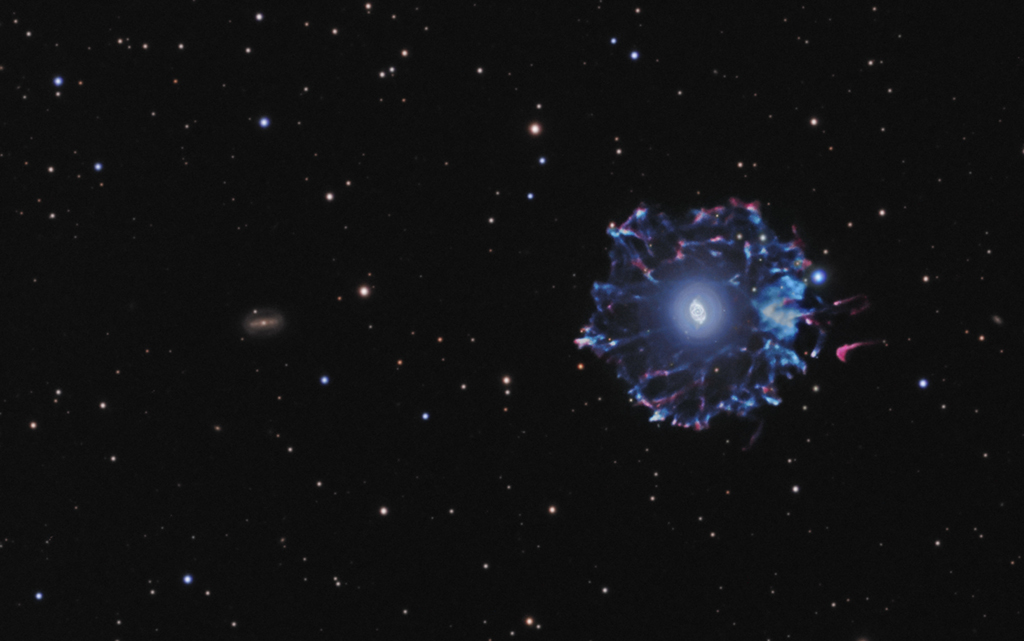 Image Credit & Copyright: Josh Smith Explanation: The Cat's Eye Nebula (NGC 6543) is one of the best known planetary nebulae in the sky. Its more familiar outlines are seen in the brighter central region of the nebula in this impressive wide-angle view. But the composite image combines many short and long exposures to also reveal an extremely faint outer halo. At an estimated distance of 3,000 light-years, the faint outer halo is over 5 light-years across. Planetary nebulae have long been appreciated as a final phase in the life of a sun-like star. More recently, some planetary nebulae are found to have halos like this one, likely formed of material shrugged off during earlier episodes in the star's evolution. While the planetary nebula phase is thought to last for around 10,000 years, astronomers estimate the age of the outer filamentary portions of this halo to be 50,000 to 90,000 years. Visible on the left, some 50 million light-years beyond the watchful planetary nebula, lies spiral galaxy NGC 6552.
__________________
όταν γράφεται η ιστορία της ζωής σου, μην αφήνεις κανέναν να κρατάει την πένα |
 |
#3533
|
 |
|
||||
|
Discover the cosmos! Each day a different image or photograph of our fascinating universe is featured, along with a brief explanation written by a professional astronomer. 2016 May 29  Image Credit: Viking Project, USGS, NASA Explanation: Mars will look good in Earth's skies over the next few days -- but not this good. To get a view this amazing, a spacecraft had to actually visit the red planet. Running across the image center, though, is one the largest canyons in the Solar System. Named Valles Marineris, the grand valley extends over 3,000 kilometers long, spans as much as 600 kilometers across, and delves as much as 8 kilometers deep. By comparison, the Earth's Grand Canyon in Arizona, USA is 800 kilometers long, 30 kilometers across, and 1.8 kilometers deep. The origin of the Valles Marineris remains unknown, although a leading hypothesis holds that it started as a crack billions of years ago as the planet cooled. Several geologic processes have been identified in the canyon. The featured mosaic was created from over 100 images of Mars taken by Viking Orbiters in the 1970s. Tomorrow, Mars and Earth will pass the closest in 11 years, resulting in the red planet being quite noticeable toward the southeast after sunset. Tomorrow's picture: watch the universe evolve Πηγή
__________________
όταν γράφεται η ιστορία της ζωής σου, μην αφήνεις κανέναν να κρατάει την πένα |
 |
#3534
|
 |
|
||||
|
Discover the cosmos! Each day a different image or photograph of our fascinating universe is featured, along with a brief explanation written by a professional astronomer. 2016 May 30 Video Credit: Donna Cox (AVL NCSA/U. Illinois) et al., NASA's GSFC, AVL, NCSA Explanation: How did the universe evolve from such a smooth beginning? To help understand, computational cosmologists and NASA produced the featured time-lapse animated video depicting a computer simulation of part of the universe. The 100-million light-year simulation starts about 20 million years after the Big Bang and runs until the present. After a smooth beginning, gravity causes clumps of matter to form into galaxies which immediately begin falling toward each other. Soon, many of them condense into long filaments while others violently merge into a huge and hot cluster of galaxies. Investigating of potential universe attributes in simulations like this have helped shape the engineering design the James Webb Space Telescope, currently scheduled for launch in late 2018.
__________________
όταν γράφεται η ιστορία της ζωής σου, μην αφήνεις κανέναν να κρατάει την πένα |
 |
#3535
|
 |
|
||||
|
Discover the cosmos! Each day a different image or photograph of our fascinating universe is featured, along with a brief explanation written by a professional astronomer. 2016 May 31  Image Credit & Copyright: Andrew Campbell Explanation: To some, it looks like a giant chicken running across the sky. To others, it looks like a gaseous nebula where star formation takes place. Cataloged as IC 2944, the Running Chicken Nebula spans about 100 light years and lies about 6,000 light years away toward the constellation of the Centaur (Centaurus). The featured image, shown in scientifically assigned colors, was captured recently in an 11-hour exposure from a backyard near Melbourne, Australia. Two star clusters are visible: the Pearl Cluster seen on the far left, and Collinder 249 embedded in the nebula's glowing gas. Although difficult to discern here, several dark molecular clouds with distinct shapes can be found inside the nebula.
__________________
όταν γράφεται η ιστορία της ζωής σου, μην αφήνεις κανέναν να κρατάει την πένα |
 |
#3536
|
 |
|
||||
|
Discover the cosmos! Each day a different image or photograph of our fascinating universe is featured, along with a brief explanation written by a professional astronomer. 2016 June 1 Video Credit: NASA, CXC, GSFC, B. Williams et al. Explanation: What star created this huge expanding puffball? Featured here is the first expansion movie ever created for Tycho's supernova remnant, the result of a stellar explosion first recorded over 400 years ago by the famous astronomer Tycho Brahe. The 2-second video is a time-lapse composite of X-ray images taken by the orbiting Chandra X-ray Observatory between the years 2000 and 2015, added to a stock optical frame. The expanding gas cloud is extremely hot, while slightly different expansion speeds have given the cloud a puffy appearance. Although the star that created SN 1572, is likely completely gone, a star dubbed Tycho G, too dim to be discerned here, is thought to be a companion. Finding progenitor remnants of Tycho's supernova is particularly important because the supernova is of Type Ia, an important rung in the distance ladder that calibrates the scale of the visible universe. The peak brightness of Type Ia supernovas is thought to be well understood, making them quite valuable in exploring the relationship between faintness and farness in the distant universe.
__________________
όταν γράφεται η ιστορία της ζωής σου, μην αφήνεις κανέναν να κρατάει την πένα |
 |
#3537
|
 |
|
||||
|
Discover the cosmos! Each day a different image or photograph of our fascinating universe is featured, along with a brief explanation written by a professional astronomer. 2016 June 2  Image Credit & Copyright: JL. Dauvergne, E. Kraaikamp, F. Colas / S2P / IMCCE / OMP Explanation: Seen any planets lately? All three planets now shining brightly in the night sky are imaged in these panels, captured last week with the 1 meter telescope at Pic du Midi Observatory in the French Pyrenees. Near opposition and closest to Earth on May 30, Mars is presently offering the best ground-based photo-ops in the last decade. The sharp image finds clouds above the Red Planet's north pole (top) and towering volcanos near its right limb. Saturn reaches its own opposition tonight, its bright rings and gaps clearly revealed in the telescopic portrait. Jupiter is currently highest during the evening twilight and shows off its planet-girdling cloud bands and Great Red Spot in this scene. Of course close-up images of the ruling gas giant will follow the July arrival of the solar-powered Juno spacecraft and JunoCam. Tomorrow's picture: pixels in space Πηγή
__________________
όταν γράφεται η ιστορία της ζωής σου, μην αφήνεις κανέναν να κρατάει την πένα |
 |
#3538
|
 |
|
||||
|
Discover the cosmos! Each day a different image or photograph of our fascinating universe is featured, along with a brief explanation written by a professional astronomer. 2016 June 3  Image Credit & Copyright: Martin Pugh Explanation: NGC 4631 is a big beautiful spiral galaxy. Seen edge-on, it lies only 25 million light-years away in the well-trained northern constellation Canes Venatici. The galaxy's slightly distorted wedge shape suggests to some a cosmic herring and to others its popular moniker, The Whale Galaxy. Either way, it is similar in size to our own Milky Way. In this sharp color image, the galaxy's yellowish core, dark dust clouds, bright blue star clusters, and red star forming regions are easy to spot. A companion galaxy, the small elliptical NGC 4627 is just above the Whale Galaxy. Faint star streams seen in deep images are the remnants of small companion galaxies disrupted by repeated encounters with the Whale in the distant past. The Whale Galaxy is also known to have spouted a halo of hot gas glowing in X-rays. Tomorrow's picture: light-weekend Πηγή
__________________
όταν γράφεται η ιστορία της ζωής σου, μην αφήνεις κανέναν να κρατάει την πένα |
 |
#3539
|
 |
|
||||
|
Discover the cosmos! Each day a different image or photograph of our fascinating universe is featured, along with a brief explanation written by a professional astronomer. 2016 June 4 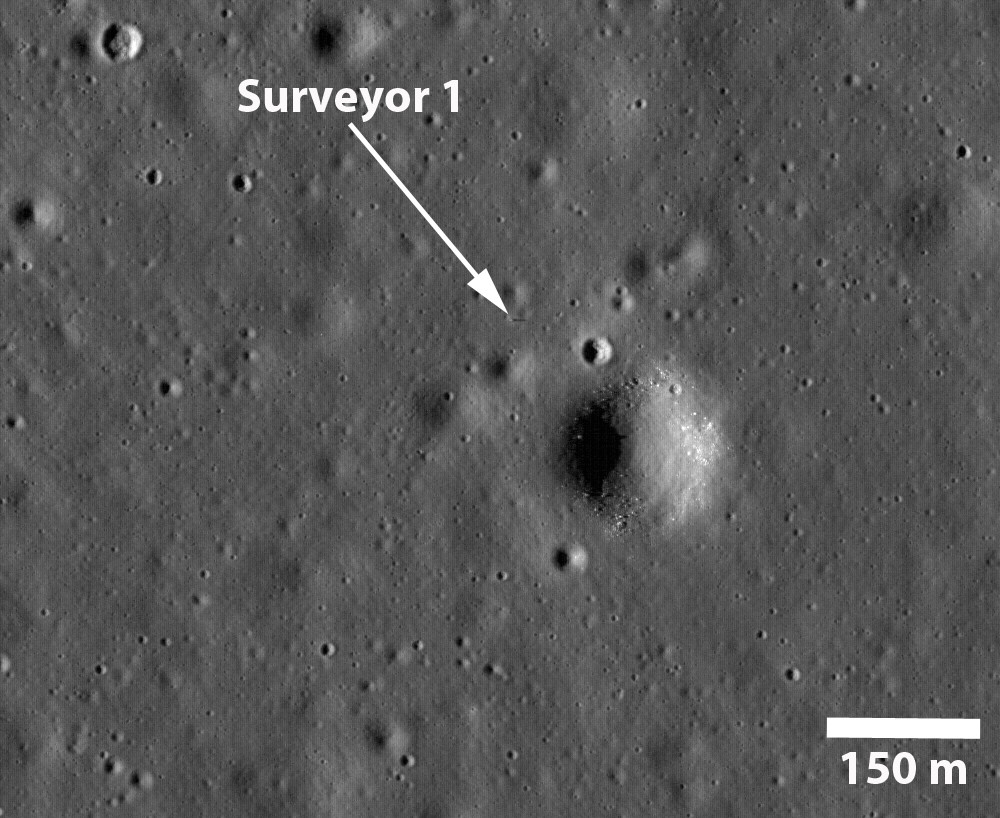 Image Credit: NASA / GSFC / Arizona State U. / Lunar Reconnaissance Orbiter Explanation: Fifty years ago, Surveyor 1 reached the Moon. Launched on May 30, 1966 and landed on June 2, 1966 with the Moon at full phase it became the first US spacecraft to make a soft landing on another world. The first of seven Surveyor missions intended to test the lunar terrain for the planned Apollo landings it sent back over 10,000 images before lunar nightfall on June 14. The total rose to over 11,000 images returned before its second lunar night began on July 13. Surveyor 1 continued to respond from the lunar surface until January 7, 1967. Captured in this 2009 image from the Lunar Reconnaissance Orbiter, the first Surveyor still stands at its landing site, a speck in the Oceanus Procellarum (the Ocean of Storms). With the Sun low on the western horizon the lonely, 3.3 meter tall spacecraft casts a shadow almost 15 meters long in the late lunar afternoon.
__________________
όταν γράφεται η ιστορία της ζωής σου, μην αφήνεις κανέναν να κρατάει την πένα |
 |
#3540
|
 |
|
||||
|
Discover the cosmos! Each day a different image or photograph of our fascinating universe is featured, along with a brief explanation written by a professional astronomer. 2016 June 5  Image Credit & Copyright: Fritz Helmut Hemmerich Explanation: It's rare that such different objects are imaged so close together. Such an occasion is occurring now, though, and was captured two days ago in combined parallel exposures from the Canary Islands of Spain. On the lower right, surrounded by a green coma and emanating an unusually split blue ion tail diagonally across the frame, is Comet C/2013 X1 (PanSTARRS). This giant snowball has been falling toward our Sun and brightening since its discovery in 2013. Although Comet PannSTARRS is a picturesque target for long-duration exposures of astrophotography, it is expected to be only barely visible to the unaided eye when it reaches its peak brightness in the next month. On the upper left, surrounded by red-glowing gas, is the also-picturesque Helix Nebula. At 700 light years distant, the Helix is not only much further away than the comet, but is expected to retain its appearance for thousands of years.
__________________
όταν γράφεται η ιστορία της ζωής σου, μην αφήνεις κανέναν να κρατάει την πένα |
 |
| Συνδεδεμένοι χρήστες που διαβάζουν αυτό το θέμα: 4 (0 μέλη και 4 επισκέπτες) | |
|
|